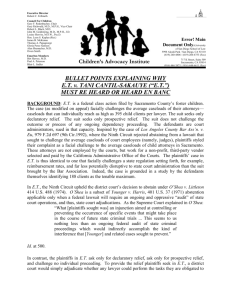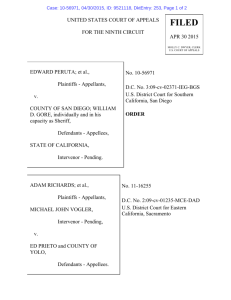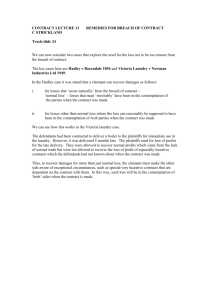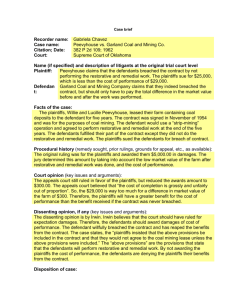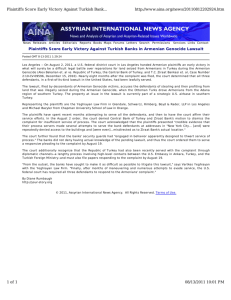IN THE HIGH COURT OF MALAYA AT KUALA LUMPUR CIVIL
advertisement
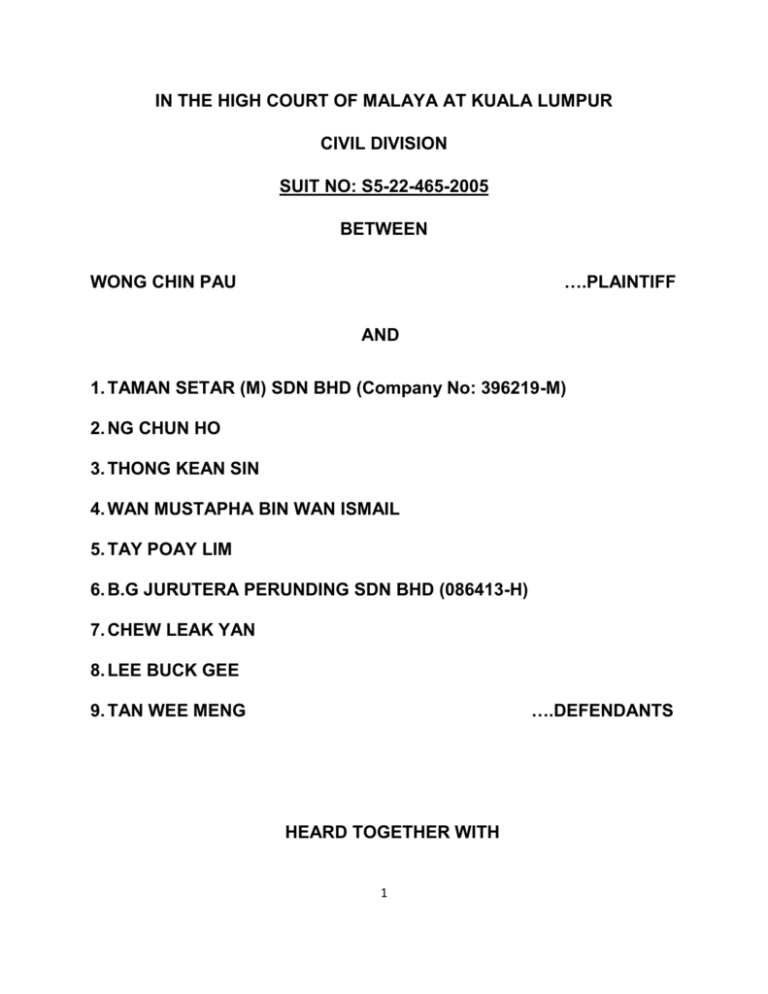
IN THE HIGH COURT OF MALAYA AT KUALA LUMPUR CIVIL DIVISION SUIT NO: S5-22-465-2005 BETWEEN ….PLAINTIFF WONG CHIN PAU AND 1. TAMAN SETAR (M) SDN BHD (Company No: 396219-M) 2. NG CHUN HO 3. THONG KEAN SIN 4. WAN MUSTAPHA BIN WAN ISMAIL 5. TAY POAY LIM 6. B.G JURUTERA PERUNDING SDN BHD (086413-H) 7. CHEW LEAK YAN 8. LEE BUCK GEE ….DEFENDANTS 9. TAN WEE MENG HEARD TOGETHER WITH 1 IN THE HIGH COURT OF KUALA LUMPUR IN THE FEDERAL TERRITORY OF MALAYSIA SUMMON NO: S6-22-582-2005 BETWEEN 1. N.S. RAGUNATHAN A/L N.S. KANAGARETNAM …PLAINTIFFS 2. HOOI PHUI KHENG AND 1. TAMAN SETAR (M) SDN BHD (Company No: 396219-M) 2. NG CHUN HO 3. THONG KEAN SIN 4. WAN MUSTAPHA BIN WAN ISMAIL 5. TAY POAY LIM 6. B.G JURUTERA PERUNDING SDN BHD (086413-H) 7. CHEW LEAK YAN 8. LEE BUCK GEE …DEFENDANTS 9. TAN WEE MENG 2 THE JUDGMENT OF JUDICIAL COMMISSIONER TUAN LEE SWEE SENG JUDGMENT Prologue The Plaintiffs in these 2 actions applied to amend their Statements of Claim after calling 7 witnesses and after the close of their case. The Defendants had commenced their Defence with 3 witnesses having been called to give evidence on behalf of the Defendants and cross-examined by the Plaintiffs’ counsel and re-examined by the 1st Defendant’s counsel. The last date of hearing was on 20 December 2010. The continued hearing was scheduled on 19 January 2011 and on 12 January 2011 the Plaintiffs filed the application to amend their Statements of Claim. One would have expected that after a trial has proceeded and the Plaintiffs have closed their case and the Defendants have proceeded with their witnesses, there would have been no more interlocutory applications. Why would there have been a need to amend the Plaintiff’s Statement of Claim at such a late stage of trial? This judgment explores both the common and 3 critical factors constituting as it were the composite factors the Court has to consider in an application by a Plaintiff to amend its Statement of Claim at such a late stage of trial after the close of the Plaintiff’s case. Parties Both the Plaintiffs in the 2 suits heard together have sued as Purchasers the 1st Defendant as Developer/Vendor for breach of some clauses of a Sale and Purchase Agreement with respect to the sale and purchase of an orchard plot in Taman Setar, Bentong with basic infrastructure works defined as “those service roads, public drains, culverts, water mains, telephone trunking and electrical mains constructed or caused to be constructed by the Vendor on and serving the Project Land at the said Lot and the other Lots.” The Plaintiffs had not stopped at that but they had also joined all the directors of the 1st Defendant as the 2nd to 5th Defendants and pleaded fraud against them with respect to the failure of the 1st Defendant to provide basic infrastructure works. The Plaintiffs also joined the 6th Defendant being the consulting engineers for the Project and the 7th to 9th Defendants being the directors of the 6th Defendant for having participated in the fraud by 4 certifying that the basic infrastructure works had been completed and for issuing the certificate of completion for the Lots. Problem The Defendants basically denied that they had failed to provide the basic infrastructure works. From the evidence of DW-1 Encik Mazlan Ali, the manager of Telekom Malaysia in Pahang testified that wired telephone lines could not be provided for the area but wireless telephone technology called Code Division Multiple Access (CDMA) is available and can be used for both voice call and internet. The Defendants also called DW-2 Mr Yap Peng Piau who appeared to be a satisfied purchaser of an orchard plot in the Project. He testified that he had built a house on his Lot and that he had a telephone line for which he had paid the telephone bills sent to him marked as Exhibit D-22. DW-2 further gave evidence that he paid a deposit of RM1,150.00 to Tenaga Nasional Berhad on 10 December 2002 and that his contractor had applied for the connection of electricity. DW-2 also produced his electricity bills marked as Exhibit D 16 a and b. DW-2 also confirmed that he has water supplied to his house and that the Developer has been supplying water without 5 charging. DW-2 continued to testify that the roads to his house was partly tarred and partly concrete and that he has been staying there since 2002 and that he used it for weekends retreat with his wife. The 1st Defendant also called its Executive Director DW-3 Major Ng Chun Hoo who inter alia produced evidence of Electricity connection activation on 29 August 2002 marked as Exhibit D-12; Telephone connection activation on 12 March 2002 marked as Exhibit D-13 and Water connection marked as Exhibit D-14. Prayer In the original prayers that Plaintiffs had only asked for general damages, special damages and costs but in the proposed amended prayers the Plaintiffs had asked for a declaration that the Defendants have breached some clauses in the Sale and Purchase Agreement; a declaration that the Defendants are jointly and severally liable for the breach of the relevant clauses of the Sale and Purchase Agreement; Specific Performance of some clauses in the Sale and Purchase Agreement with respect to the provision of basic infrastructure; in addition to damages a claim for liquidated damages at the rate stated based on the purchase price 6 (RM158,597.43 for the Plaintiff in the 1st suit and RM365,770.92 for the Plaintiffs in the 2nd suit, presumably though the figure was left blank in the proposed amendment) for the number of days of delay until vacant possession is delivered; in lieu of Specific Performance the Defendants are to refund the sum of RM158,597.43 for the Plaintiff in the 1st suit and RM RM365,770.92 for the Plaintiffs in the 2nd suit and exemplary damages of RM300,000.00 for the Plaintiff in the 1st suit and RM500,000.00 for the Plaintiffs in the 2nd suit. These proposed amendments made by the Plaintiffs after the close of the Plaintiffs’ case and after the Defendants have proceeded and completed with 3 witnesses were vigorously and vehemently objected to by all the Defendants through their counsel. Principles Amendment s of writ or pleading with leave of the Court is provided under O 20 r 5 of the Rules of the High Court 1980 (RHC). The principles governing amendment of a pleading have been succinctly and simply set out in the Federal Court case of Yamaha Motor Co. Ltd v. 7 Yamaha (M) Sdn Bhd & Ors [1983] CLJ (Rep) 428 at p. 428-429 by his Lordship Mohd Azmi FJ : “The general principle is that the Court will allow such amendments as will cause no injustice to the other parties. Three basic questions should be determined whether injustice would or would not result, (1) whether the application is bona fide; (2) whether prejudice caused to the other side can be compensated by costs and (3) whether the amendments would not in effect turn the suit from one character into a suit of another character and inconsistent character. (See Mallal’s Supreme Court Practice p.342). If the answers are in the affirmative, an application for amendment should be allowed at any stage of the proceedings particularly before trial, even if the effect of the amendment would be to add or substitute a new cause of action, provided the new cause of action arises out of the same facts or substantially the same facts as a cause of action in respect of which relief has already been claimed in the original statement of claim.” In Yamaha Motor case (supra) the proposed amendments were applied for after the close of pleadings and before trial had begun. 8 It must be noted that one factor leaning heavily towards disclosing a lack of bona fide on the part of the Plaintiffs applying for amendments is the long delay from the time the Statement of Claim was filed. As pointed out so aptly and with alacrity by the Court of Appeal in Taisho Company Sdn Bhd v. Pan Global Equities Bhd & Anor [1999] 1 CLJ 703 at p.711: “We would add further that no reasons were given for the delay in filing the application when the point of admission was obviously available even before filing the proceedings. As rightly opined by the learned JC in Multi-Pak Singapore Pte. Ltd. and correctly followed by the learned judge, the appellant did not place some material and advance some cogent reasons to impel the court to lean on its side. We would further add that the application borders on lack of bona fide, one of the basic questions set out in Yamaha Motors Co. Ltd.” The Plaintiffs have not stated any reason for the delay in making the amendments from filing the Statement of Claim on 25 April 2005 to 12 January 2011; nearly 6 years of delay. If the Plaintiff had wanted the Court to grant the Specific Performance reliefs, the Plaintiffs could have stated so at the outset, the relief being a discretionary one for the Court to decide. The facts were available then and the Plaintiffs had consciously and 9 circumspectly chosen to claim for damages instead. So too the remedy of a full refund of purchase price which is in effect a rescission of the contract. Parties are bound by their pleadings and it is certainly not for the Plaintiffs to change the goal post after the Plaintiffs have adduced all the evidence they could possibly adduce and the Defendants have commenced giving their evidence that suddenly a spark of insight and inspiration has so ignited a desire for reliefs that hitherto have been ignored. When a relief was apparent and available ab initio and the relief has not been pleaded, prayed for and pursued, the Plaintiff is deemed to have abandoned it. It is avowedly an after-thought. It behoves the Plaintiff to explain why he has not bothered to ask for the reliefs at the outset and why he has taken so long to now ask for it; otherwise he would border on if not be taken to lack bona fide in his application. Specific Performance is a discretionary remedy and the Plaintiffs must plead that they had performed their part of the contract or had been at all times ready and willing to perform their part of the contract. The Plaintiffs in the second suit had admitted that they had not paid the balance 15% of the purchase price for the purchase of their lots. There is no clear pleading in the second suit that the Plaintiffs had performed or are able and willing to perform their part of the contract in the 10 payment of the balance purchase price. See the Federal Court decision in Ganam d/o Rajamany v. Somoo s/o Sinnah [1984] 2 MLJ 290. Even if I were wrong in that finding of a lack of bona fide on the part of the Plaintiffs, I agree with the Defendants that they would be prejudiced to such an extent not compensable by costs. The reason is this: the remedy of Specific Performance arises from breach of contract by the Defendants. Here the 2nd Defendants to the 9th Defendants are not parties to the Sale and Purchase Agreement. If the amendments are allowed they would be deprived the right to apply to strike out the Statements of Claim as any application now would further delay the trial of these 2 suits. In any event an amendment should not be allowed if the Plaintiff has no prospect of succeeding in the amended claim. In Lim Yong Swan v. Lim Jee Tee [1992] 3 SLR(R) 940 at p.954, the Singapore Court of Appeal speaking through his Lordship Yong Pung How CJ observed: “This court in Jeyaretnam Joshua Benjamin v Lee Kuan Yew [1990] 2 MLJ 65 held that leave to amend a defence should not be granted where the amendment raises no reasonable defence to the claim. We were of the view that the same applies to applications for leave to amend a statement of claim. As the new causes of action did not 11 raise any reasonable causes of action, the appellant also succeeded on her alternative ground.” Further the Plaintiffs claim had been on fraud; which is why they have roped in the directors of the Developer as Defendants as well and even the consulting engineers and its directors as defendants. The Plaintiffs would need to prove beyond reasonable doubt in a claim based on fraud and conspiracy to defraud. See the case of Aik Ming (M) Sdn Bhd & 8 Ors v. Chang Ching Chuen & 3 Ors & Another Case [1995] 3 CLJ 639. The Defendants in their affidavits and their counsel in their submission to oppose the Plaintiffs application for leave to amend had averred to the fact that this move by the Plaintiffs is a tactical maneuver after the Plaintiffs had closed their case and after hearing evidence of the Defendants 3 witnesses. A claim for breach of contract need only be prove on a balance of probabilities and not beyond reasonable doubt. Witnesses will have to be recalled as the Defendants had focused their questions in cross-examination of the Plaintiffs’ witnesses on fraud and now that the Plaintiffs have prayed for Specific Performance arising from 12 breach of contract, the Defendants will have to re-strategise their Defence and recall witnesses for this purpose which would prejudice the Defendants and besides prolonging and protracting the trial; not to mention the passage of time that had passed and further time needed for the Defendants to file amended Defence. Assuming for a moment that I had been wrong in coming to the conclusion that there had been a lack of bona fide in the application made after 6 years and that the Defendants have been prejudiced beyond compensable costs, then I am constrained to conclude that the proposed amendments have all the characteristics of transforming the character of the suit from a claim in fraud to a claim in contract. If that be so, then the Plaintiffs should have sued only the 1st Defendant alone and not all the Defendants in their capacities as directors in cahoots in a conspiracy to defraud the Plaintiffs. The claim for Specific Performance is against all the directors when they are not parties to the contract. In Cynthia Gloria Louis v. Micro Consolidation Sdn Bhd & Ors [2007] 8 CLJ 554 at p. 566, Vincent Ng J (as he then was) opined as follows: 13 “I am of the considered view that the court should be strongly averse to exercise its discretion to allow substantive or material amendments at the stage after the opposite party has led his evidence in chief viva voce or after witness statement affidavits for evidence-in-chief have been admitted at the trial as it is trite law that the other party is entitled to know the case that he or she would have to meet - so as not to be taken by surprise.” Pronouncement In the light of the composite and cumulative factors considered with respect to the circumstances and context in which the amendments were sought by the Plaintiffs, I was constrained to dismiss their application for the proposed amendments. The Plaintiffs’ application was dismissed with costs of RM500.00 to each Defendant. Dated: 4 April 2011. Sgd Y.A. TUAN LEE SWEE SENG Judicial Commissioner High Court (Civil Division) Kuala Lumpur 14 For the Applicants/Plaintiffs: M. Kamalam (Messrs Kamalam & Associates) For the 1st to 5th Respondents/Defendants: Rakesh Lai & BC Poh (Messrs Avtar & Associates) For the 6th to 8th Respondents/Defendants: C F Kuan (Messrs Gan Lau & Associates) For the 9th Respondent/Defendant : Eunice Chow & SF Leong (Messrs S C Lim & Partners) Date of Decision: 19 January 2011 15
![[Click and Enter Attorney Name], State Bar No - E](http://s3.studylib.net/store/data/007177564_1-4d9407aff5e1ecb2a5922cd955484ee2-300x300.png)
